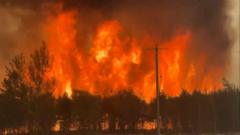With thousands already evacuated, the situation escalates as surrounding provinces declare emergencies and seek assistance.
**Wildfires Rage Across Canada: Military Aircraft Mobilized for Evacuations**

**Wildfires Rage Across Canada: Military Aircraft Mobilized for Evacuations**
Residents in Manitoba face peril as military aircraft and firefighting strategies tackle rampant wildfires.
In a dramatic escalation of the wildfire crisis in Canada, military aircraft and helicopters are now actively engaged in evacuating residents from the province of Manitoba. This timely intervention comes as fierce wildfires continue to engulf large areas of western Canada, especially impacting the central prairie provinces of Saskatchewan and Manitoba. As firefighters battle against increasing fire activity, hot and dry weather forecasts contribute to future concerns. Over 180 fires are currently reported, with dense smoke infiltrating not only Canada but parts of the United States as well.
Both Saskatchewan and Manitoba have proclaimed states of emergency, in place for the next month, while coordinating efforts to secure international firefighting support. Breathtaking aerial footage depicts thick smoke plumes billowing from the ongoing wildfires, creating a stark visual representation of the destructive spread. Authorities are especially focused on the urgent evacuation of the northern First Nations community of Pukatawagan, described as a "rapidly evolving situation" by local officials.
On the ground, the Canadian Armed Forces, in collaboration with the Manitoba Wildfire Service and the province's Heavy Urban Search and Rescue Team, are utilizing military resources to assist in the evacuation process. As the situation stands, more than 2,000 residents from Pukatawagan are pending transport as of Friday, amid reports that only essential personnel remain in Flin Flon, a nearby city of 5,000.
Manitoba's fire situation report indicates a total of 25 ongoing fires, of which 10 are classified as out of control. The crisis extends beyond Manitoba, as Saskatchewan grapples with 16 active wildfires as of Saturday, seven of which remain uncontained. The Canadian Interagency Forest Fire Centre has labeled conditions in Saskatchewan as extreme.
Meteorological forecasts provide little relief, as Danielle Desjardins from Environment and Climate Change Canada highlights that while a cold front may sweep into some regions, it could exacerbate fire conditions due to increased wind velocity. Currently, the adverse weather conditions are ripe for additional wildfire propagation.
In an unexpected ripple effect, smoke from the fires is impacting air quality significantly, with alerts issued affecting around 22 million Americans. States such as Michigan, Wisconsin, and parts of Minnesota have been particularly affected, prompting health advisories that extend through the weekend.
This year marks a historic wildfire season in Canada, with over 42 million acres (17.3 million hectares) scorched. As these fires are a natural occurrence in many parts of the world, the UN's climate body warns that climate change is amplifying the conditions under which wildfires can thrive, thus increasing their frequency and intensity.
Both Saskatchewan and Manitoba have proclaimed states of emergency, in place for the next month, while coordinating efforts to secure international firefighting support. Breathtaking aerial footage depicts thick smoke plumes billowing from the ongoing wildfires, creating a stark visual representation of the destructive spread. Authorities are especially focused on the urgent evacuation of the northern First Nations community of Pukatawagan, described as a "rapidly evolving situation" by local officials.
On the ground, the Canadian Armed Forces, in collaboration with the Manitoba Wildfire Service and the province's Heavy Urban Search and Rescue Team, are utilizing military resources to assist in the evacuation process. As the situation stands, more than 2,000 residents from Pukatawagan are pending transport as of Friday, amid reports that only essential personnel remain in Flin Flon, a nearby city of 5,000.
Manitoba's fire situation report indicates a total of 25 ongoing fires, of which 10 are classified as out of control. The crisis extends beyond Manitoba, as Saskatchewan grapples with 16 active wildfires as of Saturday, seven of which remain uncontained. The Canadian Interagency Forest Fire Centre has labeled conditions in Saskatchewan as extreme.
Meteorological forecasts provide little relief, as Danielle Desjardins from Environment and Climate Change Canada highlights that while a cold front may sweep into some regions, it could exacerbate fire conditions due to increased wind velocity. Currently, the adverse weather conditions are ripe for additional wildfire propagation.
In an unexpected ripple effect, smoke from the fires is impacting air quality significantly, with alerts issued affecting around 22 million Americans. States such as Michigan, Wisconsin, and parts of Minnesota have been particularly affected, prompting health advisories that extend through the weekend.
This year marks a historic wildfire season in Canada, with over 42 million acres (17.3 million hectares) scorched. As these fires are a natural occurrence in many parts of the world, the UN's climate body warns that climate change is amplifying the conditions under which wildfires can thrive, thus increasing their frequency and intensity.





















